
Concept explainers
You are building additional storage space in your garage. You decide to suspend a 10.0-kg sheet of plywood of dimensions 0.600 m wide by 2.25 m long from the ceiling. The plywood will be held in a horizontal orientation by four light vertical chains attached to the plywood at its corners and mounted to the ceiling. After you complete the job of suspending the plywood from the ceiling, you choose three cubic boxes to place on the shelf. Each box is 0.750 m on a side. Box 1 has a mass of 50.0 kg, box 2 has a mass of 100 kg, and box 3 has a mass of 125 kg. The mass of each box is uniformly distributed within the box and each box is centered on the front-to-back width of the shelf. Unbeknownst to you, one of the chains on the right-hand end of your shelf is defective and will break if subjected to a force of more than 700 N. There are six possible arrangements of the three boxes on the shelf, for example, from left to right, Box 1, Box 2, Box 3, and Box 1, Box 3, Box, 2, and four more. Which arrangements are safe (that is, the defective chain will not break if the boxes are arranged in this way), and which arrangements are dangerous?
The arrangement of the boxes that are safe and the arrangement of the boxes that are dangerous.
Answer to Problem 1P
The arrangement of the boxes that are safe are
Explanation of Solution
Given info: The mass of the sheet of the plywood is
The chains are all hinged at the center only so the angle made by the chain with the plywood is
The free body diagram of the arrangement
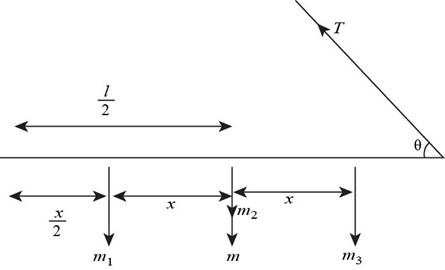
Figure (1)
Take the moment in the above diagram on the left end.
Here,
Substitute
So the tension in each chain in arrangement
The free body diagram of the arrangement
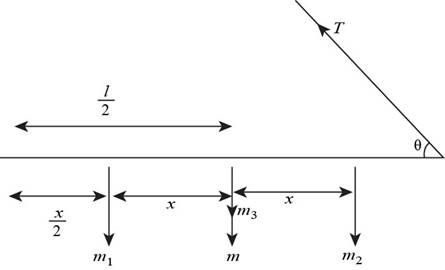
Figure (2)
Take the moment in the above diagram on the left end.
Substitute
So the tension in each chain in arrangement
The free body diagram of the arrangement
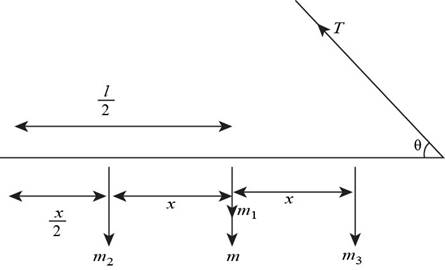
Figure (3)
Take the moment in the above diagram on the left end.
Substitute
So the tension in each chain in arrangement
The free body diagram of the arrangement
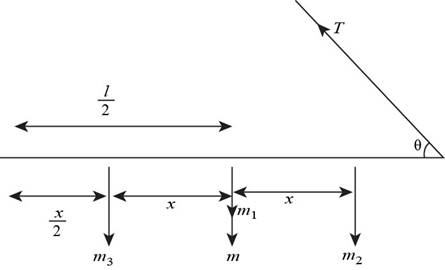
Figure (4)
Take the moment in the above diagram on the left end.
Substitute
So the tension in each chain in arrangement
The free body diagram of the arrangement
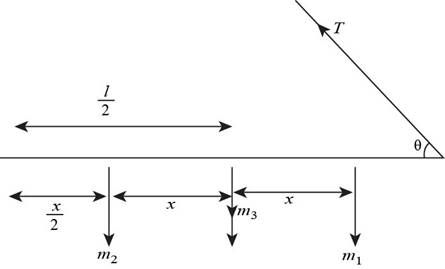
Figure (5)
Take the moment in the above diagram on the left end.
Substitute
So the tension in each chain in arrangement
The free body diagram of the arrangement
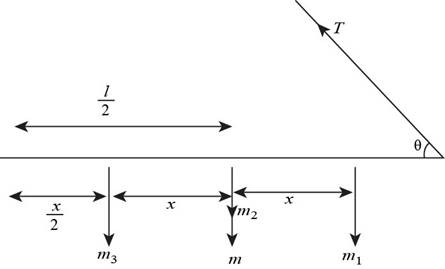
Figure (6)
Take the moment in the above diagram on the left end.
Substitute
So the tension in each chain in arrangement
Conclusion:
Therefore, the arrangement of the boxes that are safe are
Want to see more full solutions like this?
Chapter 12 Solutions
Physics for Scientists and Engineers with Modern Physics
- At a distance of 0.212 cm from the center of a charged conducting sphere with radius 0.100cm, the electric field is 485 N/C . What is the electric field 0.598 cm from the center of the sphere? At a distance of 0.196 cmcm from the axis of a very long charged conducting cylinder with radius 0.100cm, the electric field is 485 N/C . What is the electric field 0.620 cm from the axis of the cylinder? At a distance of 0.202 cm from a large uniform sheet of charge, the electric field is 485 N/C . What is the electric field 1.21 cm from the sheet?arrow_forwardA hollow, conducting sphere with an outer radius of 0.260 m and an inner radius of 0.200 m has a uniform surface charge density of +6.67 × 10−6 C/m2. A charge of -0.800 μC is now introduced into the cavity inside the sphere. What is the new charge density on the outside of the sphere? Calculate the strength of the electric field just outside the sphere. What is the electric flux through a spherical surface just inside the inner surface of the sphere?arrow_forwardA point charge of -3.00 μC is located in the center of a spherical cavity of radius 6.60 cm inside an insulating spherical charged solid. The charge density in the solid is 7.35 × 10−4 C/m3. Calculate the magnitude of the electric field inside the solid at a distance of 9.10 cm from the center of the cavity. Find the direction of this electric field.arrow_forward
- An infinitely long conducting cylindrical rod with a positive charge λ per unit length is surrounded by a conducting cylindrical shell (which is also infinitely long) with a charge per unit length of −2λ and radius r1, as shown in the figure. What is E(r), the radial component of the electric field between the rod and cylindrical shell as a function of the distance r from the axis of the cylindrical rod? Express your answer in terms of λ, r, and ϵ0, the permittivity of free space. What is σinner, the surface charge density (charge per unit area) on the inner surface of the conducting shell? What is σouterσouter, the surface charge density on the outside of the conducting shell? (Recall from the problem statement that the conducting shell has a total charge per unit length given by −2λ.) What is the radial component of the electric field, E(r), outside the shell?arrow_forwardA very long conducting tube (hollow cylinder) has inner radius aa and outer radius b. It carries charge per unit length +α, where αα is a positive constant with units of C/m. A line of charge lies along the axis of the tube. The line of charge has charge per unit length +α. Calculate the electric field in terms of α and the distance r from the axis of the tube for r<a. Calculate the electric field in terms of α and the distance rr from the axis of the tube for a<r<b. Calculate the electric field in terms of αα and the distance r from the axis of the tube for r>b. What is the charge per unit length on the inner surface of the tube? What is the charge per unit length on the outer surface of the tube?arrow_forwardTwo small insulating spheres with radius 9.00×10−2 m are separated by a large center-to-center distance of 0.545 m . One sphere is negatively charged, with net charge -1.75 μC , and the other sphere is positively charged, with net charge 3.70 μC . The charge is uniformly distributed within the volume of each sphere. What is the magnitude E of the electric field midway between the spheres? Take the permittivity of free space to be ϵ0 = 8.85×10−12 C2/(N⋅m2) . What is the direction of the electric field midway between the spheres?arrow_forward
- A conducting spherical shell with inner radius aa and outer radius bb has a positive point charge Q located at its center. The total charge on the shell is -3Q, and it is insulated from its surroundings. Derive the expression for the electric field magnitude in terms of the distance r from the center for the region r<a. Express your answer in terms of some or all of the variables Q, a, b, and appropriate constants. Derive the expression for the electric field magnitude in terms of the distance rr from the center for the region a<r<b. Derive the expression for the electric field magnitude in terms of the distance rr from the center for the region r>b. What is the surface charge density on the inner surface of the conducting shell? What is the surface charge density on the outer surface of the conducting shell?arrow_forwardA small sphere with a mass of 3.00×10−3 g and carrying a charge of 4.80×10−8 C hangs from a thread near a very large, charged insulating sheet, as shown in the figure (Figure 1). The charge density on the sheet is −2.20×10−9 C/m2 . Find the angle of the thread.arrow_forwardA small conducting spherical shell with inner radius aa and outer radius bb is concentric with a larger conducting spherical shell with inner radius c and outer radius d (Figure 1). The inner shell has total charge +2q, and the outer shell has charge −2q. Calculate the magnitude of the electric field in terms of q and the distance rr from the common center of the two shells for r<a. Calculate the magnitude of the electric field for a<r<b. Calculate the magnitude of the electric field for b<r<c.arrow_forward
- A cube has sides of length L = 0.800 m . It is placed with one corner at the origin as shown in the figure. The electric field is not uniform but is given by E→=αxi^+βzk^, where α=−3.90 and β= 7.10. What is the sum of the flux through the surface S5 and S6? What is the sum of the flux through the surface S2 and S4? Find the total electric charge inside the cube.arrow_forwardIn the figure, a proton is projected horizontally midway between two parallel plates that are separated by 0.6 cm. The electrical field due to the plates has magnitude 450000 N/C between the plates away from the edges. If the plates are 3 cm long, find the minimum speed of the proton if it just misses the lower plate as it emerges from the field.arrow_forwardA point charge of magnitude q is at the center of a cube with sides of length L. What is the electric flux Φ through each of the six faces of the cube? What would be the flux Φ1 through a face of the cube if its sides were of length L1? Please explain everything.arrow_forward
 Physics for Scientists and EngineersPhysicsISBN:9781337553278Author:Raymond A. Serway, John W. JewettPublisher:Cengage Learning
Physics for Scientists and EngineersPhysicsISBN:9781337553278Author:Raymond A. Serway, John W. JewettPublisher:Cengage Learning Physics for Scientists and Engineers with Modern ...PhysicsISBN:9781337553292Author:Raymond A. Serway, John W. JewettPublisher:Cengage Learning
Physics for Scientists and Engineers with Modern ...PhysicsISBN:9781337553292Author:Raymond A. Serway, John W. JewettPublisher:Cengage Learning Physics for Scientists and Engineers: Foundations...PhysicsISBN:9781133939146Author:Katz, Debora M.Publisher:Cengage Learning
Physics for Scientists and Engineers: Foundations...PhysicsISBN:9781133939146Author:Katz, Debora M.Publisher:Cengage Learning Principles of Physics: A Calculus-Based TextPhysicsISBN:9781133104261Author:Raymond A. Serway, John W. JewettPublisher:Cengage Learning
Principles of Physics: A Calculus-Based TextPhysicsISBN:9781133104261Author:Raymond A. Serway, John W. JewettPublisher:Cengage Learning University Physics Volume 1PhysicsISBN:9781938168277Author:William Moebs, Samuel J. Ling, Jeff SannyPublisher:OpenStax - Rice University
University Physics Volume 1PhysicsISBN:9781938168277Author:William Moebs, Samuel J. Ling, Jeff SannyPublisher:OpenStax - Rice University College PhysicsPhysicsISBN:9781938168000Author:Paul Peter Urone, Roger HinrichsPublisher:OpenStax College
College PhysicsPhysicsISBN:9781938168000Author:Paul Peter Urone, Roger HinrichsPublisher:OpenStax College





